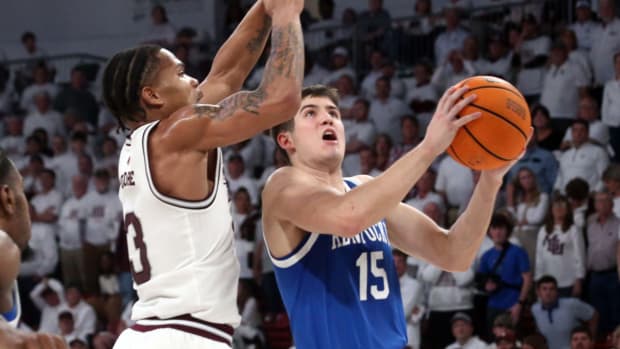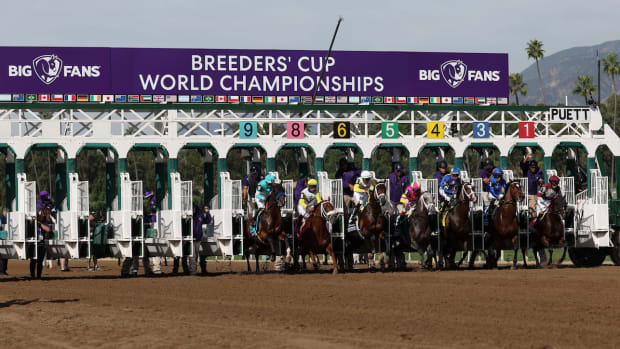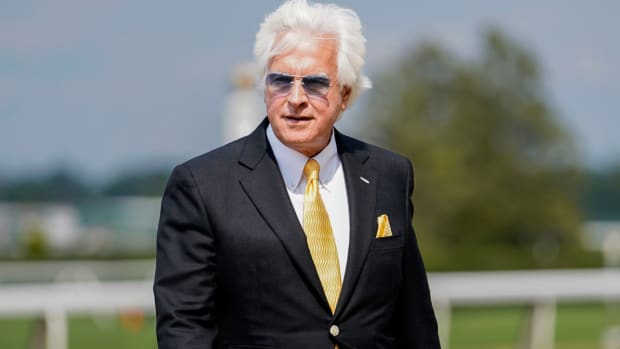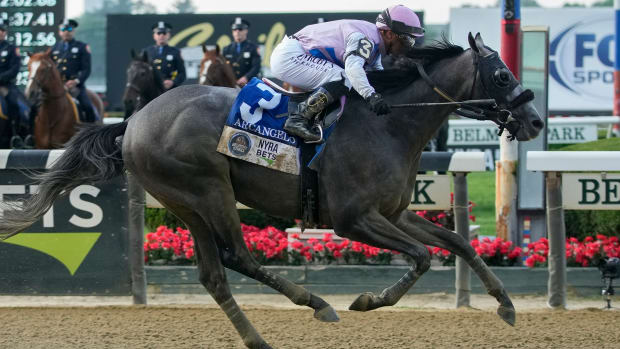Why the Revamped Triple Crown Dates Could Actually Be a Win for Horse Racing
If there is one sport positioned to come out of the global pandemic in a better place than it went in, it’s thoroughbred racing.
That’s a departure from normal for a sport that could screw up a one-car parade. But for once, racing is getting it right with its newly reconfigured Triple Crown. Or at least close to right.
The New York Racing Association announced Tuesday that the Belmont Stakes will be contested June 20, with no fans. That’s two weeks later than it had been scheduled, and the race will be contested at a considerably shorter distance: 1 1/8 miles as opposed to the usual 1 1/2. For the first time in Triple Crown history, the last shall be first.
That filled out the Triple Crown dance card. The Kentucky Derby previously had been moved from its eternal first-Saturday-in-May slot to Sept. 5, and on Saturday the Preakness announced its relocation from mid-May to Oct. 3.
And thus, one of the most rigid sporting constructs in American history has been temporarily reinvented in a way that could be really good.
We will have better spacing between races, more mature horses, and hopefully fuller and more competitive fields for all three legs. And a shake-up of the ancient dynamics offers some freshness to the musty series: the Belmont, which sometimes is huge and sometimes a complete anticlimax, gets first run; the Preakness, forever the overlooked middle child, has a chance to stage a grand finale; and the Derby will retain its cachet as America’s greatest race while also experiencing some fleeting humility over its new place in the Triple Crown batting order.
Are there drawbacks? Of course. Every sporting event in 2020 will have drawbacks, if they happen at all.
The Belmont’s distance downsize eliminates the race’s “Test of a Champion” mystique. At 1 1/8 miles and going around just a single turn, it will be the shortest Triple Crown race since the Preakness was run at that distance in 1924. In terms of a rare challenge, this isn’t it—might as well be the Blue Grass Stakes. But shortening up all the way to nine furlongs instead of the Derby’s 10 does at least continue the tradition of all three races being different lengths.
MORE: The Flukish, Fascinating Rise—and Sudden Disappearance—of the 2019 Kentucky Derby Champion
Contesting the Belmont without fans significantly impacts NYRA’s bottom line and kills one of the better atmospheres on the racing calendar. New Yorkers piling off the trains from the city dressed up and ready to party adds an energy to cavernous, old Belmont Park. Could a move to August have left open the possibility for fans in the stands? Maybe in some locales, but not likely in hard-hit New York. Besides, NYRA also runs the Saratoga meet in late summer and hopscotching operations between those races and the Belmont in Long Island would be difficult.
Moving to late October or early November and retaining the usual Triple Crown order would butt up agains the Breeders’ Cup, which is scheduled for Nov. 6–7. While the casual sports fan considers the Triple Crown more important than the Cup races, those within the industry do not. Owners and trainers of the best 3-year-olds would have had to make a choice between those two events, and the Belmont might not have liked how that choice went down.
So June 20 it is. Depending on what is happening with Major League Baseball, the NBA and the NHL, the race could well command a prime spot on an otherwise sparse sporting calendar. Even a Belmont with a Triple Crown on the line competes with NHL and NBA playoffs; not so this time.
The Derby and Preakness must deal with life in the shadow of King Football, but that’s just the way this fall is going to go. The Masters is in November, facing the same predicament. The Derby at least is scheduled before the NFL season starts, if that starts on time.
And it’s inevitable that some standout 3-year-olds of the spring will not be able to sustain their brilliance (and physical soundness) into the fall. While spacing between the races is improved, it’s not ideal. It figures to be difficult for the best horse on Belmont day to still be the best horse some 75 days later on Derby day.
“Would have preferred the traditional Triple Crown but we are all just trying to get through this,” trainer Bob Baffert said to Sports Illustrated in a text message. “Glad they didn’t cancel them. It will still be very exciting races and probably tougher because of the time between races.”
Baffert had mastered the five-week grind of the traditional Triple. He’s swept all three races twice, in 2015 with American Pharoah and in ’18 with Justify, and won a total of 15 Triple Crown races (five Derbies, seven Preaknesses, three Belmonts). His powerful, deep-pocketed stable has been built on precocious speed, getting horses ready early in their 3-year-old seasons to take a swing at the biggest prizes on the racing calendar.
At present, his barn is bursting with talent that is gaudy even by Baffert standards. He trains three of the top four 3-year-olds in the National Thoroughbred Racing Association’s most recent Top 10—top-rated Nadal, No. 3 Charlatan and No. 4 Authentic. That may be a flush Belmont hand, but where are they come the big race in September?
If you’re Baffert, there’s always a taxi squad to work with. That includes a well-bred, unraced prospect named Cezanne who scorched his first public workout earlier this month. And that may be what the fall legs of the Triple Crown come down to—horses that weren’t ready for the spring grind but step forward in the late summer and early fall. A couple months can make a big difference.
More mature horses tend to be better horses, and hopefully less prone to injury. The recovery time between races will only help in terms of health, and presumably in terms of ownership groups’ interest in contesting all three. Most non-Derby winners are looking for any excuse to skip the Preakness two weeks later, but this time they have four. A lot of owners and trainers don’t like the Belmont’s normal marathon distance, but now it’s more manageable. And nobody ever looks for reasons to skip the Derby.
So the Triple Crown seemingly has a chance at three well-stocked, compelling fields for three well-spaced races. It would continue what has been a strangely fortuitous 2020 for the sport.
Racing has continued at several tracks during the pandemic, and as the only game in town (or on Earth) that has led to some staggering betting handles. Fonner Park in Grand Island, Neb., rocketed from low-rent obscurity to a gambler’s oasis, raking in 10 times the wagering year-over-year from February through April. Churchill Downs started its spring meet late but with a wallop: $26.6 million in wagering on opening weekend, up 185% from last year’s opening weekend.
In a sporting (and betting) vacuum, the flawed and anachronistic racing game has an opening and is taking advantage of it. The reimagined 2020 Triple Crown gives the sport a chance to further seize that opening.
Tradition is wonderful. But sometimes breaking with tradition—however briefly—can be liberating.





